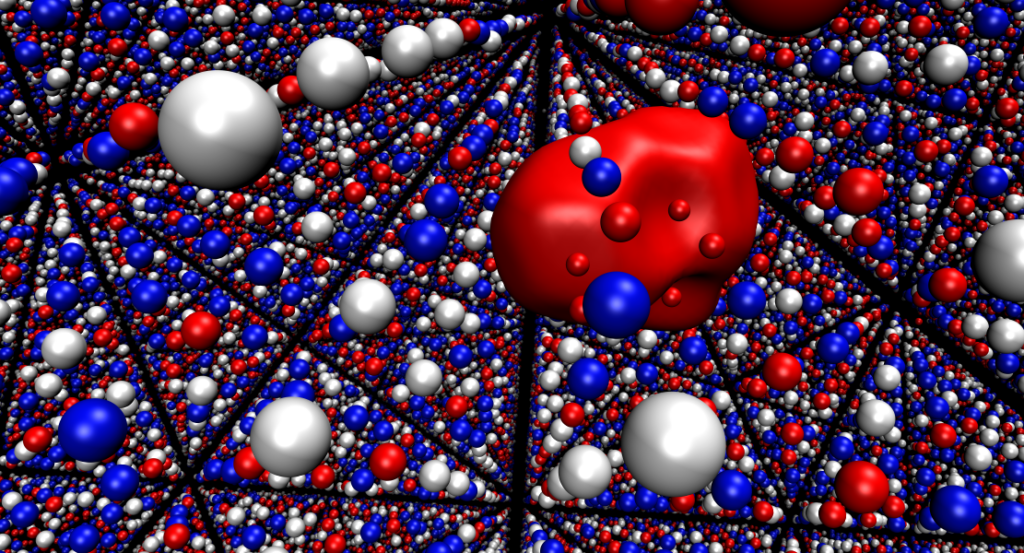2018-2020 / Archived Project
Project leader: Ilja Makkonen
The development and characterization of new materials for extreme environments is at the core of technological needs of big science. Large installations where the structural materials face physical and chemical environments that are extremely hostile – such as large particle accelerators, fusion experiment devices, or nuclear power plants – are either already facing or rapidly approaching the stage where ageing becomes a serious issue. These conditions lead to processes that cause a variety of changes in the materials, ranging from oxidation to transmutation, the retention of hydrogen in the structure, void swelling, stress corrosion cracking, irradiation-assisted stress corrosion cracking, or simply reduction of fracture toughness. Choosing and developing materials for next-generation facilities is critical for cost and environmental efficiency. To develop novel materials, it is crucially important to understand the coupling of the processes from atomistic to macroscopic scales. This HIP Technology Project focuses on two classes of materials. First of all, a novel materials class, the high-entropy alloys (HEAs) that can be tailored to suit multiple potential applications, and secondly, tungsten (W), an important plasma-facing material to be used in future fusion reactors.

Simulation of positron localization (red isosurface) in irradiated NiCoCr concentrated solid solution alloy.
High entropy alloys are a relatively new class of metallic alloys that contain five or more elements in nearly equivalent ratios and research related to this group of materials is barely 15 years old. HEAs differ significantly from conventional metallic alloys such as steel-based Fe-C alloys, cupronickels and bronze, where there are one or two main elements with other alloying elements clearly in the minority. The most investigated HEA system is the Cantor alloy (FeCrMnNiCo). Global interest towards HEAs lies in the exceptional properties of these alloys such as unique corrosion or abrasion resistance, radiation hardness, or performance at extreme (either low or high) temperatures. HEA performance under extreme conditions (corrosive environments, particle radiation) is a global hot topic, while the fundamental understanding of these types of materials from the atomic to macroscale is currently missing from the scientific literature.
W is relied on as the plasma-facing material in ITER, one of the world’s most ambitious energy projects. The irradiation environment in the high-temperature fusion plasma is extremely hostile, eventually leading to the deterioration of thermal properties and loss of mechanical integrity of this so-called first wall. It is of paramount significance for the functioning of the reactor that this material preserves its structural integrity throughout its planned lifetime. Our ability to accurately and reliably determine the physical properties of radiation-induced defects currently limits the reliability of predictive modeling of the evolution of radiation damage.
The main general goal is to advance the fundamental understanding of HEA and W properties through highest-quality internationally networked collaborative research. There are two main aspects in the project’s own local research at UH, the experimental characterization and first-principles calculations of the metals and metallic alloys as well as defects and defect clusters inside. The modeling can be used to predict such properties as defect formation energetics, diffusion and segregation of elements in the alloys, and also make a link between the microscopic defect structure of the alloys and the indirect information contained in the measured spectra. The group has recently moved to the Accelerator lab of UH from Aalto University. Combining the group’s positron beams and spectrometers with irradiation facilities at Acclab will create a unique facility for in-situ measurements of irradiation damage.
Goals for 2019: New fundamental information on the properties of single-phase solid solution metallic alloys with few constituents, as well as on the durability of W in heavy irradiation conditions. Analysis and publishing of recent positron annihilation results for irradiated as well as corroded HEAs. New experiments involving irradiation and characterization at cryogenic temperatures. Studies of hydrogen-induced microstructural evolution and hydrogen-lattice defect effects with the thermal desorption technique.
Collaboration:
- Flyura Djurabekova, HIP Technology Programme, Accelerator Technology Project, materials modeling, large-scale molecular dynamics irradiation simulations
- Mari Lundström, Hydrometallurgy and Corrosion group, Aalto University School of Chemical Engineering, complementary analysis in corrosion and degradation studies;
- Jyrki Räisänen, Accelerator Laboratory, University of Helsinki. Irradiation experiments;
- Yanwen Zhang, Oak Ridge National Laboratory, USA, fabrication of HEAs and model alloys, radiation damage analysis, advanced characterization;
- Prof. Zhiming Li, School of Materials Science and Engineering, Central South University, Changsha, China, fabrication of HEAs and model alloys, advanced characterzation;
